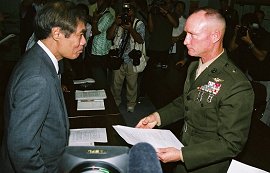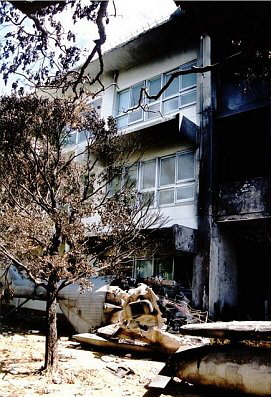 |
 |
 |
 |
 |
 |
|
continued from part 3, The Occupation
|
|
|
|
Ginowan City Mayor Yoichi Iha commented that the crash provided conclusive evidence of the dangers posed by the base. He also joined the chorus of voices demanding an immediate end to flights, and urged citizens to express their anger over the incident through protests.
|
|
|
The same type of aircraft has caused fatal accidents three times since 2002, most recently in Anbu Province, Iraq only two days before the Okinawa International University crash. See our Public Safety pages for more detailed information on the atrocious safety record of these helicopters.
|
|
|
 |
|
|
|
U.S. military officials apologize to the university with looks of sincere contrition on their faces.
|
|
|
Three days after the crash, Deputy Commanding General of Marine Corps Bases, Japan, Brig. Gen. James F. Flock visited Okinawa International University to apologize for the incident. Adding insult to injury, the proceedings were interrupted at one point by the roar of military aircraft as flights resumed from Futenma air base. Was this some sort of stunt intended to demonstrate that the U.S Marines can do whatever they damn well please whenever they damn well feel like it?
|
|
|
Despite the apology, police were still denied entry to the site. By the time Japanese police were finally allowed to investigate the site a week later, all of the evidence had been removed, and there was virtually nothing left to investigate. The military even removed the topsoil.
Trees were removed as well. University officials were notified that five or six trees would have to be removed. But the Marines then removed about thirty, including irreplaceable trees planted more than thirty years ago to commemorate the founding of the university.
|
|
|
|




